Searching for Ara Güler’s Istanbul
When Mustafa Kemal Atatürk came to power his intention was to start progressive reforms to change the outdated Ottoman Empire into a modern, secular and industrialized nation. Ironically, at the same time, the last Sultan, a short time before he lost power, got a traffic fine. A thing unthinkable of a short while before. He had overtaken a car on the Galata bridge. The fine is framed and exposed in the Dolmabahce palace. Moving the capital to Ankara was not so much a practical decision but a symbol that the government not only abandoned the sultanate politically but also geographically.
However, next to a different political system the changes introduced by Atatürk involved a lot of reforms which also affected personal life.
Turkish had been written in Arabic. Atatürk introduced the western Latin-based alphabet. At the same time primary education became compulsory and free. Thousands of schools were opened all over the country. They also replaced the islamic medressas, koran based schools.
The new government also strove for equal rights for women. Men were not allowed to marry more than one woman any more. Women were given voting rights in local elections in 1930, and in general, in 1934. In Atatürk’s opinion a western citizen had to wear a hat. The Fes as male head cover was forbidden. At the same time women were not allowed to cover their faces any more.
Interesting enough today you can see all of that in the streets again. There are veiled girls in burka and headscarf walking down with a friend in tight jeans or a mini-skirt. Muslim women don’t seem to see the clothes as an issue. You are free when you can do what you want. In the city the free spirit mixes with the more traditional habits of migrants from the countryside, or recently, immigrants.
Altogether Turkey hosts 3.1 million Syrian refugees and almost 300 000 refugees and asylum seekers of other nationalities. In Istanbul alone there are more than half a million Syrian refugees. They are not only different in their clothing and habits. For immigrants the turkish laws of a minimum wage and social security do not apply. Locals therefore complain that the immigrants spoil their conditions of living.
It turns out that the friendly and efficient young chap at the reception of my hotel is from Syria. With his family he came to Turkey in 2009 when he was 9 years old. They have no intention to go back. It would be dangerous. His well educated father has a good job and he himself was accepted at the university to study software engineering. However, he complains that there are resentments against refugees, in particular Syrians.
Refreshment from the heat
The night porter is from Tunesia. He is not a refugee but came her for work. In Tunesia he would earn a maximum of 200 € per month. However, he loves his country and wants to go back. He recommends me to go there, see all the historic places and enjoy the beaches and good hotels. He has worked in one of the big tourist hotels on the island of Djerba and full of nostalgia shows me pictures on his phone.
Shoe shine stand
Today there is a new Sultan. The only difference is that he is called a president. Children again can go to islamic schools, the medresses, and the Sufi and Dervish orders strive. Rights for women or minorities, the press, the western ideas have to give way for the final goal, make Turkey great again.
Orhan Pamuk was born in 1952. Kemal Atatürk was long dead by then and his reforms widely introduced. However, when he was a child he still saw much of the traditional, old-fashioned Istanbul. A lot is described in his book “Istanbul: Memories of a City”.
The book is illustrated with lots of photographs. Many of them are taken from the archives of one of Turkey's most famous photographer, Ara Güler. Güler was born in 1928 and died in 2018. He became the leading documentarian of the modernization of Turkey and in particular of his city, Istanbul. Pamuk and Güler knew each other well and they were selecting the pictures together.
The arrival of the modern traveler breaks with all traditions shown in the old pictures. Historic travelers arrived by boat. Their first impression were the minarets of the many mosques appearing above the seven hills of New Rome on the horizon. From the 19th century on travelers could have arrived by train. Traditionally the station where European travelers arrived at was Sirkeci. The Orient express ended here. Across the Bosporus was Haydarpaşa station. For ongoing travelers this would be the point where the trains to Eastern Turkey, Syria or Iran would depart. A ferry connected the two stations. Both offer a view of the minaret dotted skyline of the old town. The night train from Sofia, the last remnant of the great Orient express, does not terminate at Sirkeci but in Haflaki, a suburb 35 km outside. From there you have to take the metro into town (see part 15). The Sirkeci metro station is a modern building hidden away in a quiet street. This would also be where somebody, well most of the people nowadays, would arrive taking the metro from the airport.
After arrival I had to carry my backpack up the hill from the metro station into the neighborhood below the hippodrome where the hotel is. Everything around me is either modern or renovated in this antiseptic area. Around Sultanahmet, the Blue mosque, Hagia Sophia, Topkapi Palace and the Hippodrome everything caters for the tourist. There are many hotels, frequently newly built and modern, tourist shops and restaurants in standard buildings which could be anywhere between Lisbon and Delhi. Tourist Police is omnipresent and keeps the area, which was notorious for pickpockets and touts, safe.
1.5 million tourists were visiting Istanbul in April 2024. The peak season is summer when the numbers rise to almost 2 million per month. That is a considerable number even in such a big city. It is bound to change the aspect of the neighborhoods these people visit and the prices, also for the locals. But not all the visitors come as tourists. Istanbul is for example a very popular destination to get cosmetic surgery since it is very cheap. A hair transplant for men comes at around 2000 €.
Climbing up from the Galata bridge a very modern tram crosses the historic and touristic part of town and it is striking that the long trains, coupled to units even longer, find the space between the shops and restaurants which are housed in the ground floor of the houses below Topkapi Palace. The stops are fenced off and you can only enter the platform after you have swiped your Istanbul card – and have enough saldo on your ticket. But between the stops people cross the tracks at any time and it is a miracle that nobody is run over.
The tram line continues to the west of the old town and beyond. It passes a modern pedestrian zone area with up-market hotels and shops, the Grand Bazar and the Beyazid mosque.
The túnel
On the other side of the Galata bridge, in the former European neighborhood, is the “tünel”. In 1875 the metropolitan railway of Constantinople opened the first metro on the European continent. With 573 m it also the shortest. The “tünel” runs uphill from near the Galata bridge. The first line of the London Underground was opened in 1863 and the Budapest Metro in 1896 years.
When you exit the upper terminus of the tünel you can continue with a conventional tram. It is not one of the modern trams which snake along in the other parts of the city but a revived old streetcar. Istanbul had an extensive network of tram lines originating from horse trams first introduced in 1860. The first electric tram-line opened in 1912. In 1956 there were 56 lines. By 1966 this old network, which also features on many of Ara Güler’s photographs, had been closed down completely. The first line of the modern network opened in 1992. The historic line between tünel and Taksim square opened in 1990. In 2003 another historic line was opened on the other side of the Bosporus in the Asian part of Istanbul.
There are lots of nice restaurants in the historic part of town. The prices are on the same level as any European capital. The minimum wage in Turkey is 11400 lira, about 325 €, per month. The wages in Istanbul are higher, but the other parts of the country are much poorer. How can people afford this price level? Where do they live?
It turns out you see very few Turks in the restaurants of the tourist district. When guests around here appear to be Muslim or Arabic they probably not Turkish but form Saudi Arabia, Oman or Usbekistan. There attitude is a mix of arrogance and greediness. In front of me a very fashionable young Omani couple orders very little and bargain about the price before ordering and again when the bill comes. The waiters react with admirable politeness. Another group tries to get a special deal for writing positive reviews in tripadvisor.
Restaurant Passage in Galata
This is monumental historic Istanbul packed into a modern City catering for the visitors. But where can I find the real Istanbul described by Orhan Pamuk and made immortal by Ara Güler’s photographs? Where are the old wooden houses, the markets, the little workshops? Is it all gone?
Ara Güler loved to take pictures around the Galata bridge. The bridge is the main connection between the old town and the former European neighborhood, the area around the Galata tower where already in the late Byzantine era the European powers like Venice or Genova had their trading compounds and where nowadays many embassies and consulates are located in the middle of western type shops.
Fishermen on the Galata bridge
The bridge itself served as the open air stall of all kinds of traders. The Dutch author Geert Mak has written a little book about them. In 2006 he spent several month getting to know the people on and under the bridge, the tea seller, the book merchant, the insole seller, the boys who illegally sell cigarettes. Most of them can barely survive, live by the day and have a hidden story. Many came from the countryside because they expected a better life and conditions for their family.
Today, on the square at the foot of the bridge mobile stalls sell street food. There are a couple of flying merchants in the chaotic little mall under the ramp on the Galata side. But nobody resembles those kind of merchants Mak describes. Where are they now?
Today the top of the bridge is for the tourists and the odd fisherman. Under the bridge are restaurants. The tram passes over the center of the bridge. Even the traffic is gone.
One of the things which attracted Ara Güler to this area where the boats. Eminomu on the old town side of the bridge and Karaköy on the Galata side are the main stops for the many ferries plying the waters of Golden Horn, Bosporus and Kadikoy. In Güler’s time, before the metro was built, everybody had to take the ferry. For me it is a perfect way to escape the humdrum of the city, get some rest and still see the city from the water.
Touts along the piers try to sell boat tours along the Bosporus or Golden Horn. However, a regular ferry boat leaves from Eminomu and goes all the way up the European shore of the Bosporus to Sariyer. There are several places where you can change to other boats crossing the Bosporous and there is a ferry plying the shore on the Asian side.
The boat traffic on the Bosporus and the Golden Horn is very busy. It is a wonder that there are no accidents, in particular close to the narrow passage under the Galata bridge. The ferry up the Bosporus runs about every hour. That gives the opportunity to hop off from time to time, have a look around and then continue with the next boat.
The rich families of the Ottoman era including the Sultan himself escaped the old city by building mansions along the shore of the Bosporus. Many of the mansions which were called Yali had their own access to the water, where families were sitting in the hot summer evening enjoying the breeze.
Young Orhan Pamuk watched these wooden houses burning down one by one. For him it was the sign of a changing era. While he and his mates cruised along the shore in heavy cars listening to Creedence Clearwater Revival they saw the reflecting lights of the fires symbolizing the downfall of the good old times.
Renovated Yali
Not all of those beautiful Yalis are gone. Or are all these renovated buildings which I see from the ferry new constructions? Only very few old ones look empty, abandoned, every piece of glass gone and the paint faded leaving bare gray wood.
Next to the ferry stop in Sariyer there is a little fishing harbor. Rusty trawlers wait for their next trip. The promenade is lined with little restaurants. Now in the early afternoon it is quiet and there are hardly any guests. I get a plate of calamari and the waiter seems to be disappointed that I don’t order more.
Orhan Pamuk refers to hüzün, the melancholia which rules over life in Istanbul. It is a city which is disconnected from its great past. It lost an empire, its status as capital and as a center of history. The golden times are gone and will never come back. This applied in particular for his family, where the father and uncle wasted away the fortune accumulated by the grandfather in inept business transactions. But is the melancholia still justified?
Istanbul never had so many inhabitants and international visitors. Business towers at the horizon proof that there is a lot of foreign investment. Old parts of the town are renovated.
That he made hüzün apparent in his pictures is the biggest appeal of Ara Güler’s photographs. Dark silhouettes of burdened workman contrast a background where the skyline of the minarets of old Istanbul fade away in the heavy smog. Chaotic harbor scenes with ferries covered in soot emitting a cloud of black smoke. Alleys of decrepit wooden houses where lone figures pursue their arduous way. Long shadows of porters toiling their heavy loads up impossible inclines.
Uskudar ferry landing
Although some of the older ferry boats still emit an impressive cloud of smoke most of the boats are not dirty any more. The air is much cleaner today and the smog seems to be gone. Or is it the time of the year, when a fresh breeze brings clean air into the hot town?
In each big town where I arrive I first try to join one of the free walking tours. In Istanbul the tour is done by an energetic young woman. Pina is 27 and progressive with her tight jeans and white blouse. There is a mother with son from Australia, he on an extended stay in Europe, she visiting. The others are from Canada, Kenia, France, Germany, Argentina and Slovakia. Gina is eager to make clear that the real Istanbul is not around Hagia Sophia and the Topkapi Palace. To see the old Istanbul she recommends to go to Balat and Fener, the old Greek and Jewish neighborhoods.
The process of modernization and secularization which culminated in the formation of a secular Turkish state under Kemal Atatürk also came with a high degree of nationalism. Notwithstanding its backwardness, the ottoman imperium was a multi-ethnic, multi-religious society with a high degree of tolerance. In 1914, 25% of the population of Istanbul were Armenian, in 1920 that were only 8.5%. In 1914 the town had 250000 Greek inhabitants, in 2006 only 2000 were left. 99% of the population of modern Istanbul are muslim who frequent the 4000 mosques.
Minorities in Turkey were ordered to speak Turkish in public although the use of their own languages was tolerated in private and within their own communities. Non-Turkish toponyms were replaced. Since family names were not common in Turkey they were introduced by Atatürk and also non-Turkish families were ordered to adopt a Turkish surname. It could happen that an old farmer, who went to register his new name, left from the registration office with the last name “Gunaydin”. That was the word he had said when he entered the office: “good morning”.
Consequently the Greek and Jews are gone from Balat and Fener. They were replaced by the tourists who have long discovered this old neighborhoods at the Golden Horn at the base of the hill. The restaurants and hotels here are smaller, more alternative.
In the Ottoman times the poor were living in the lower parts of the town, and the rich on top of the hills. Literally the poor were living at the bottom where the shit collected after coming down from the top of the hills where the rich and the rulers lived.
An old man sits at a street corner. On a blanket next to him all kinds of cheap jewelry. He asks were I come from. And certainly, he has got a brother who lives very close, in Rotterdam. If I would have said I am from Austria, he would have discovered that his brother just moved to Innsbruck. He explains to me where the street of the umbrellas is. They have suspended colorful umbrellas to offer some shade in a pedestrian zone full of tourist shops. It is an attraction. He offers me a nazar boncuğu, the blue white and black charm which is said to protect from the evil eye. For free. When I take it from his outstretched arm, he also gives me some necklace for my wife. And for the daughters he has more to offer. I give everything back. I am still looking for Ara Güler’s old Istanbul. But he does not know who Ara Güler is.
Gates of the old Bazar
Suddenly I am in the middle of a market. Next to me a fountain where people bend down to drink some water. A medieval gate gives access to narrow alleys lined with dark cavernous shops. Every alley seems to offer a different article. There is an alley for childrens shoes and another for clogs. There is an alley for little girls’ dresses and another for headscarfs.
The alleys are full of people. There is a colorful mix, from women completely covered in black to girls in mini skirts, old men with mustache and smart young guys glued to the phone like anywhere. The atmosphere is busy like in an ants heap. I retreat into a corner along the wall to not form an obstacle in the steady stream of movement. What I see is not much different from the markets in Jodhpur or a bazar in Cairo.
Some of the passages are steep. There is no space for a car, let alone a truck. All transport has to be done by porters. Some carry the goods on their back, some have some kind of cart. Many carts have very little wheels and are put together from some spare wood.
Porters bring cases, bales of fabric or casks. After climbing up or pushing up their card the steep hill they have to take a rest in a shady corner. Their chest moves quickly in a desperate quest for air while beads of sweat flow down their forehead.
Others carry trays with little cups of tea and coffee. One carries a tray of food. On his t-shirt the print “Firat kebab house”. He delivers the tray to a guy sitting in front of his shop waiting for a customer. I follow him into a dark alley. He brings me to the source of food, a kebab house taking orders to deliver their food to the shops in the surrounding bazaar.
Bringing food to the shops
There are some tables outside in a covered passage. I make a gesture to one of the guys and he ushers me inside to show me the selection of food in the counter. I order an Adana kebab and lemonade. Then I sit down at one of the tables. I look up and my view falls on a number of faded colored umbrellas suspended above the alley. A guy comes with a sack barrow and delivers iron bars to a work shop in a grotto down below to the right.
I take a picture. A young chap brings my food and notices my camera. He brings his father and asks me to take a picture.
There is no doubt. I have found Ara Güler’s Istanbul. A city that will never die.
Orhan Pamuk, Istanbul: Memories of a City
John Freely, De Geschiedenis van Istanbul, Olympus, Dutch translation, 2006
Geert Mak, De brug, 2006

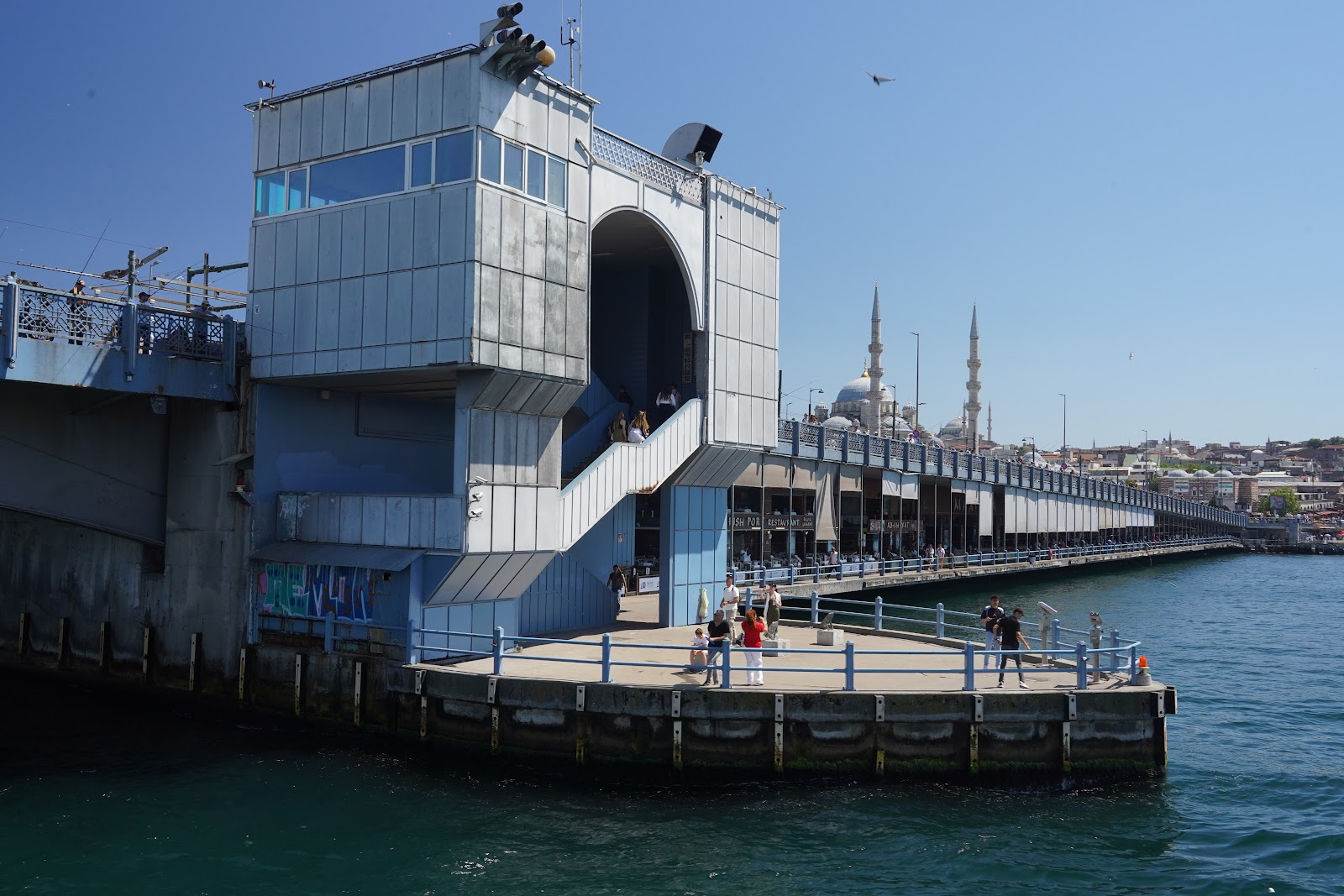

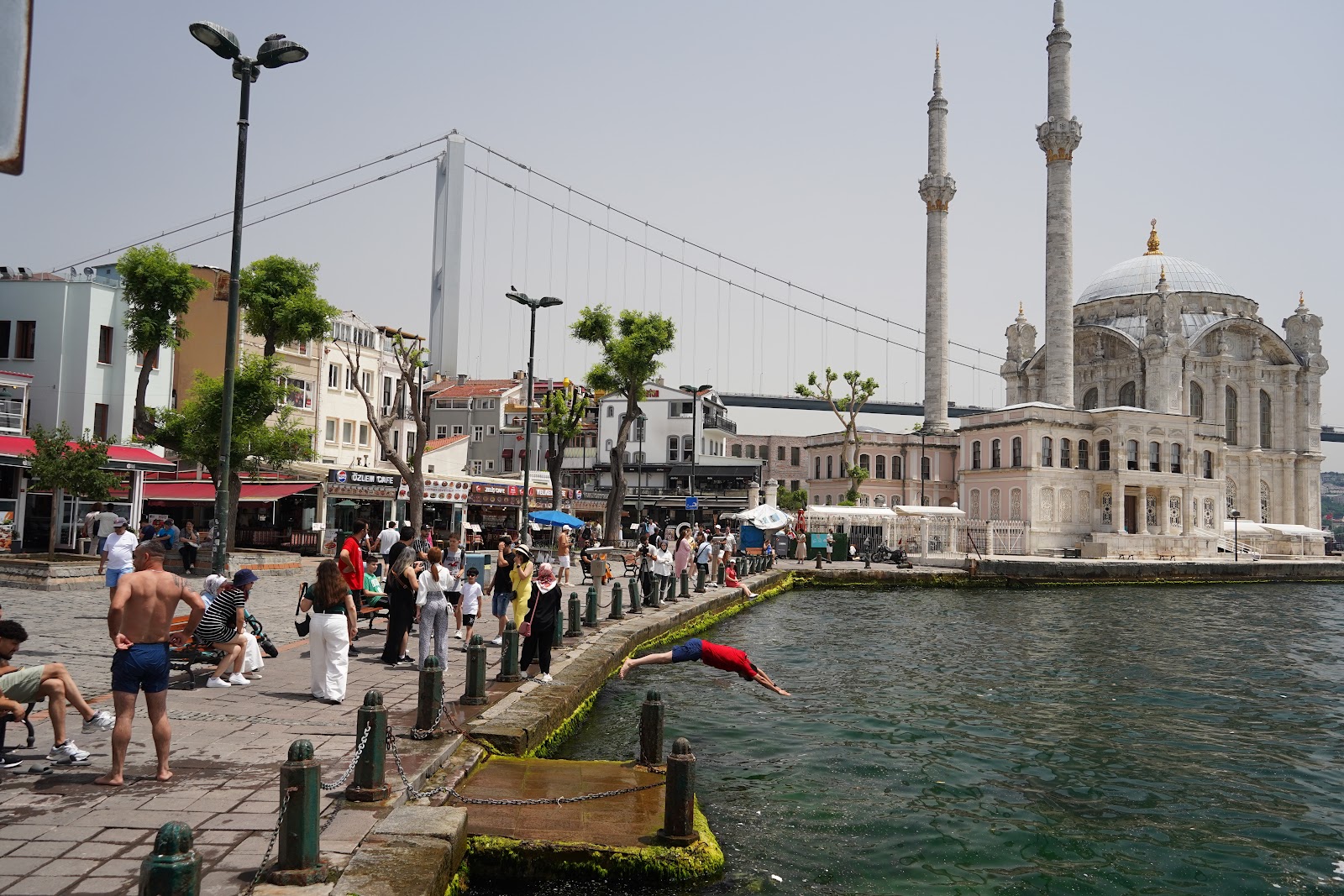












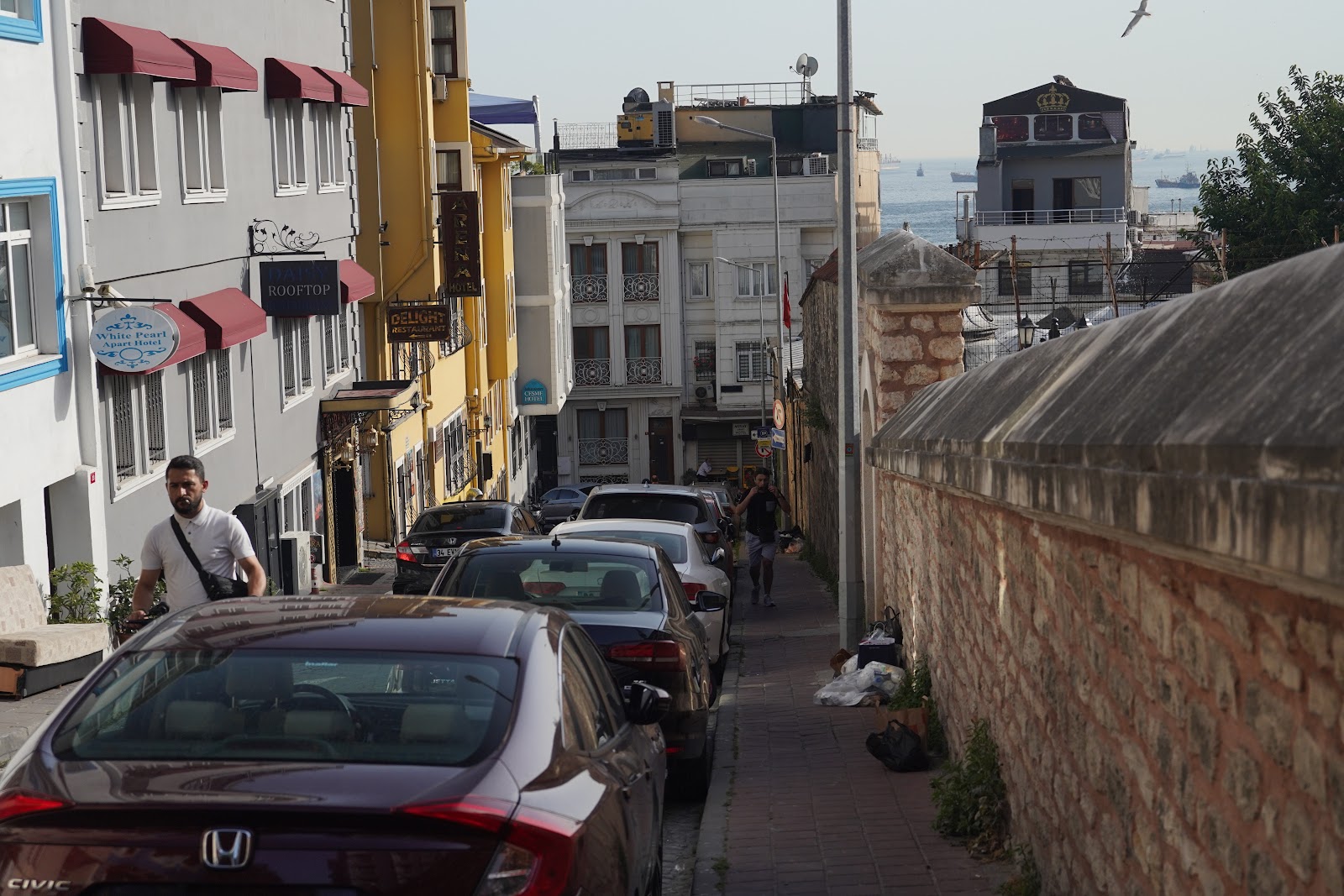


















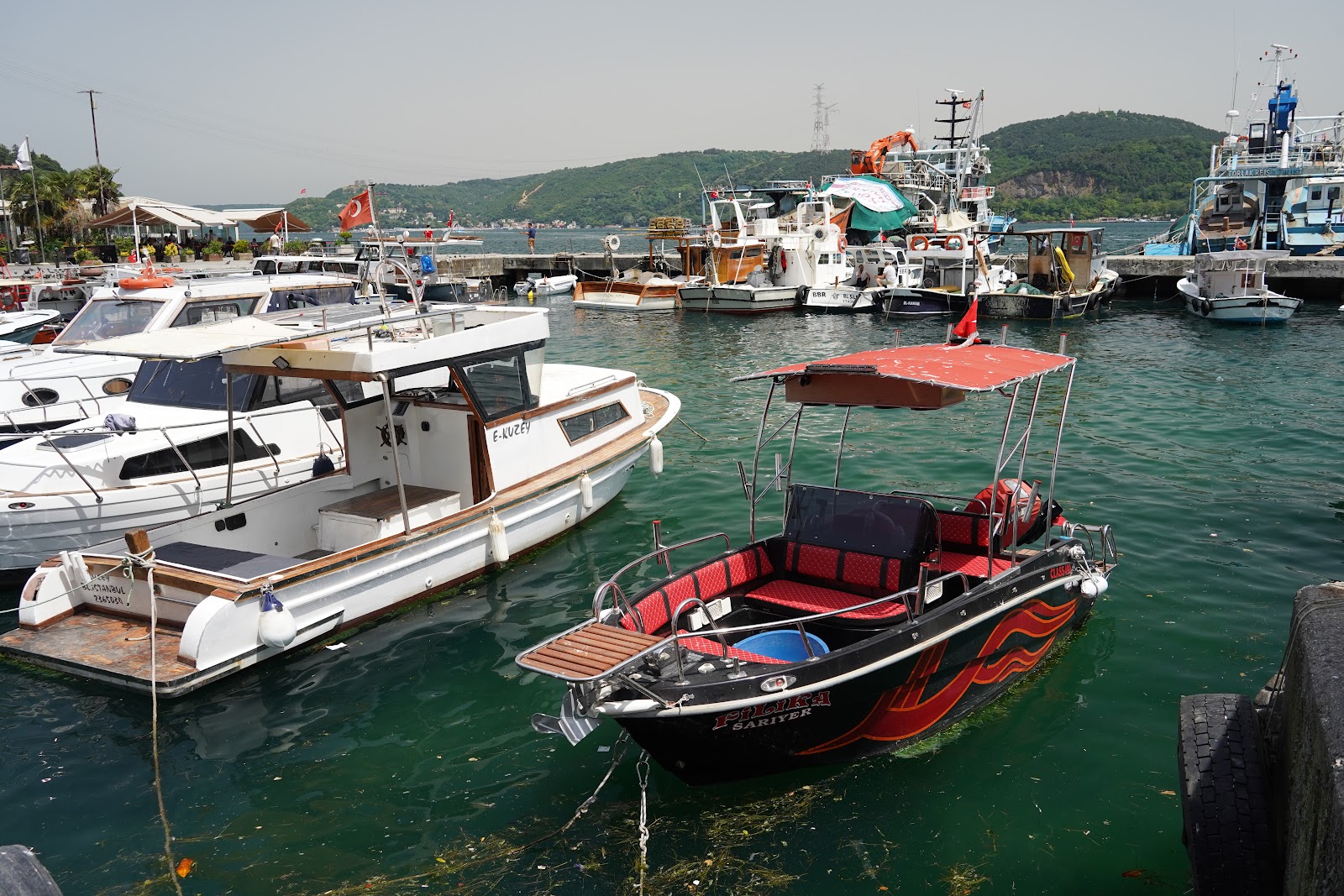

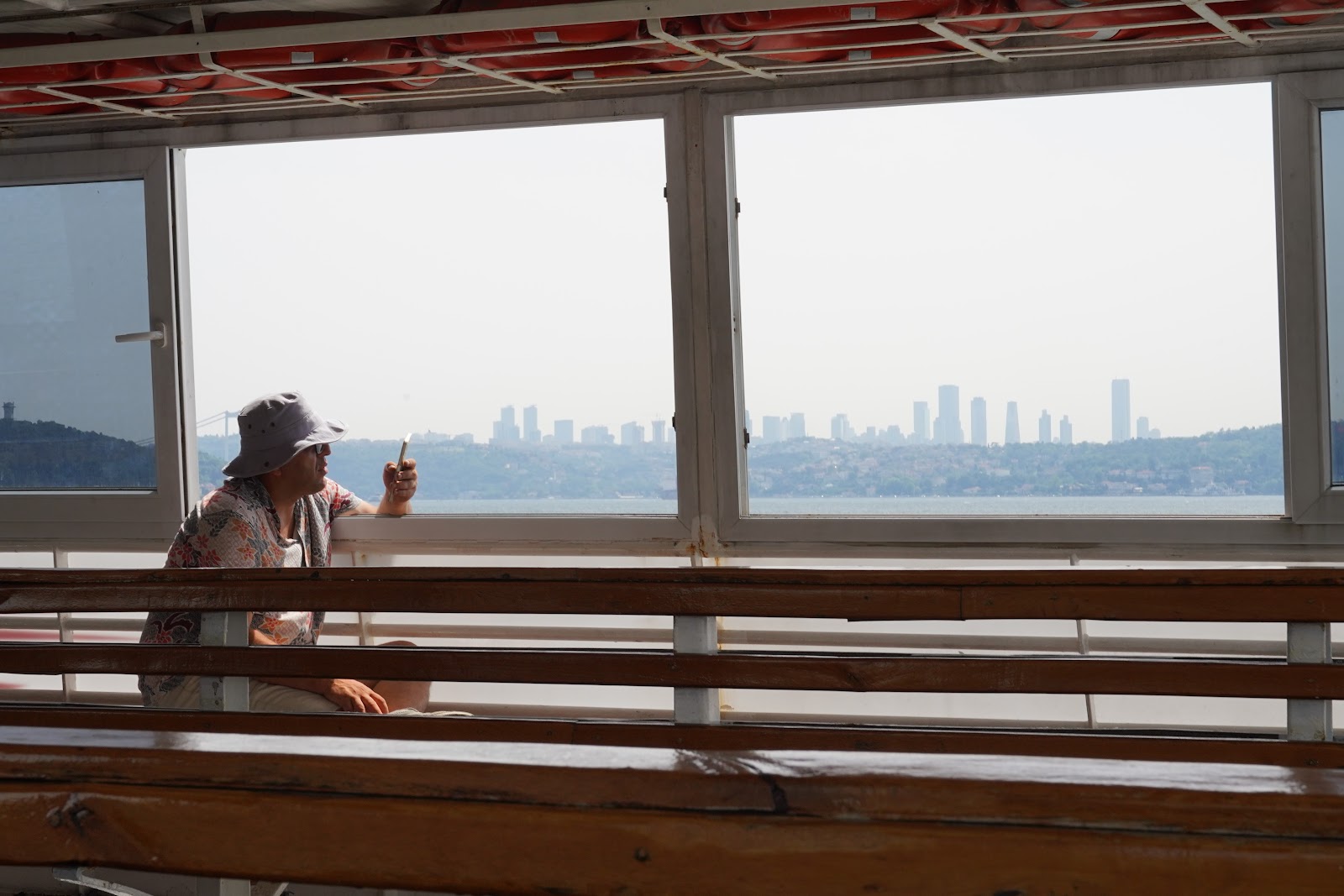

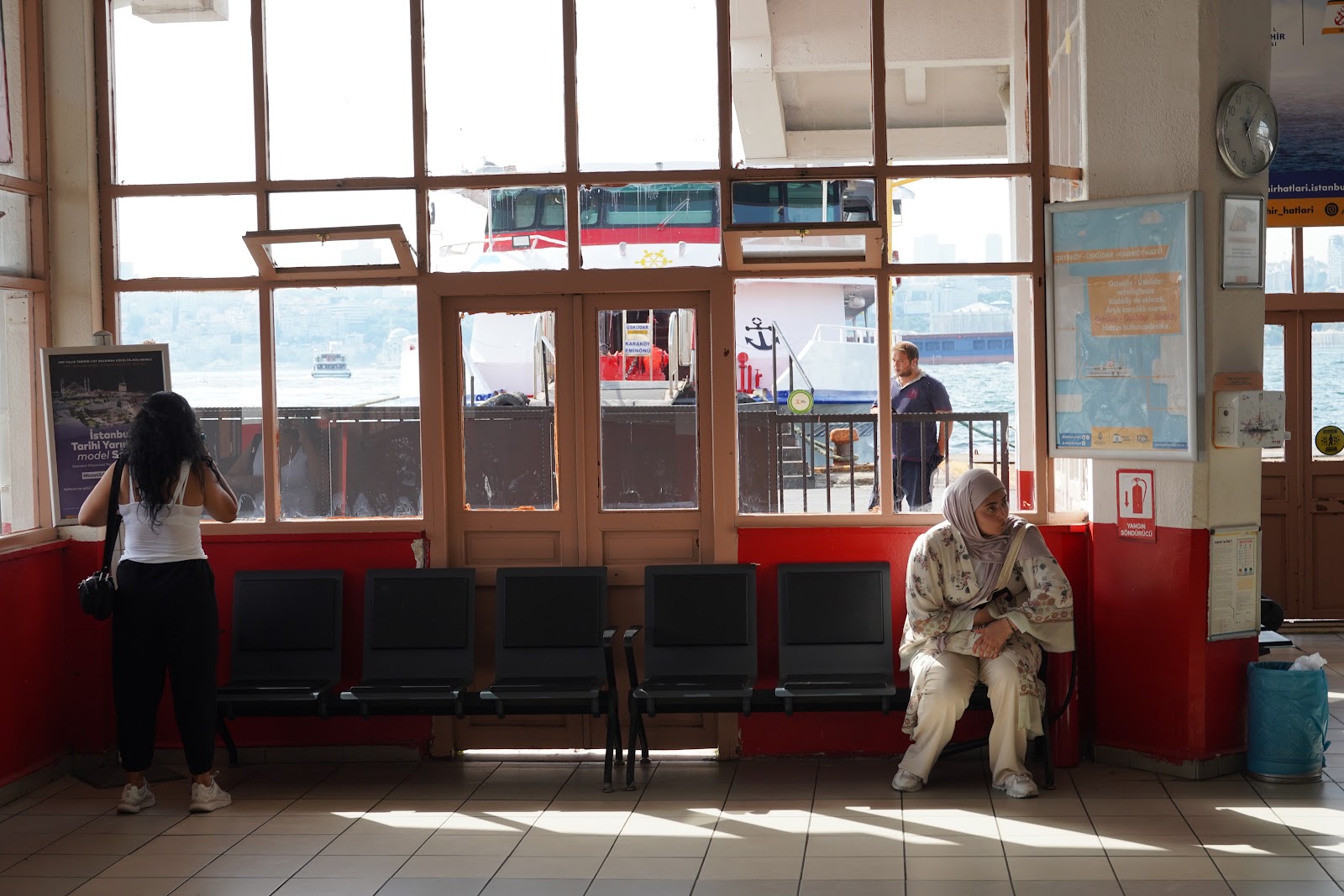







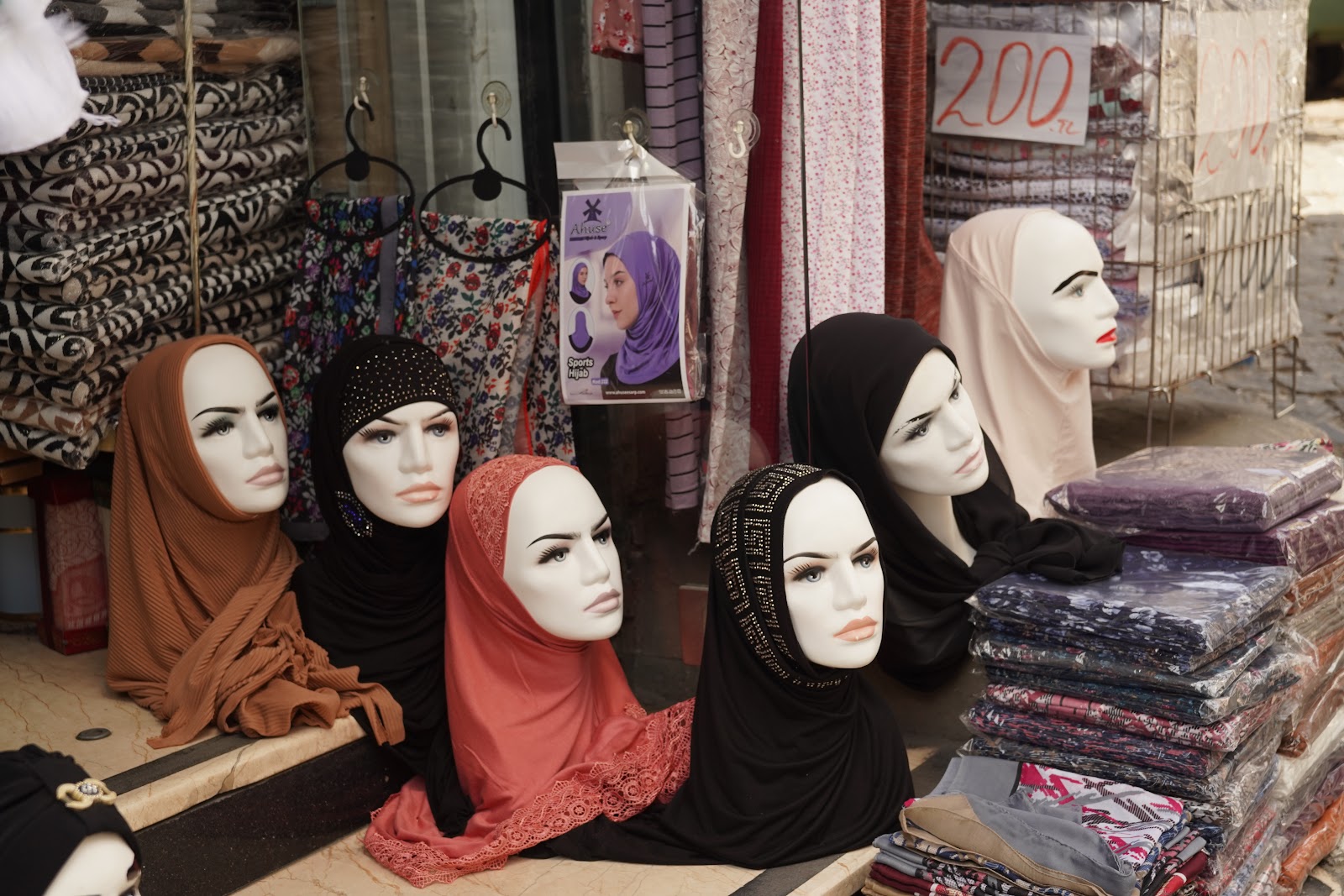



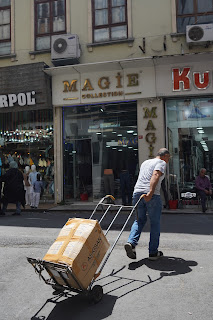





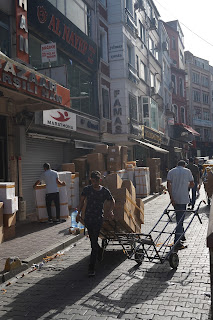

No comments:
Post a Comment